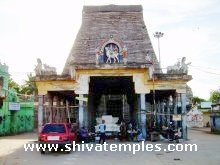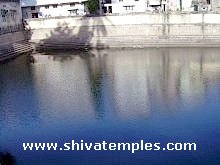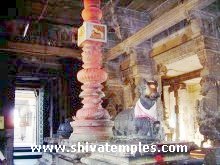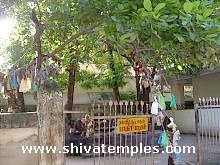Temple Layout - This east facing temple is marked by a pillared mandapam in the front and a magnificent Rajagopuram at the back of it. The Rajagopuram stands tall and is full of exquisite sculptures

'Shivakaratheertham', the temple pond is near by and is easilly accessible by steps.

The gateway leads to the outer prakaram and we can see a copper-armoured dwajasthambam, balipeetam and Nandi. These are placed on an elevated platform and as we do a 'pradakshina' in the outer prakaram, we do not see any other sannidhis.

An inner gateway guarded by Vinayaka and Subramanya as 'Dwarapalaka's leads to the inner chamber of the temple. As walk inside, and turn left in the inner prakaram, we can see a sannidhi for Chandra (the planetorial god for moon), the 'Urchava' idol of Tirunavukkarasar and the sanctum of the presiding Deity. Tirunavukkarasar's depiction in a seated posture with folded hands is unique to this temple. As we proceed along the inner prakaram, we can see the 63 Nayanmars. Next is the 'Sthala-Vinayaka' known as Kanni Vinayaka holding a 'Padhiri Malar' (flower of the yellow snake tree) in his hands. It is believed that Kanni Vinayaka assisted Parvathy Devi during her penance. Other deities in this prakaram include Urchava' idols, A Linga worshipped by Sages Vyagrapadha and Agasthya, Meenakshi Sundareshwarar and Muruga. Muruga is in a north-facing sannidhi, seated with one leg folded on a peacock. His two consorts Valli and Deivanai stand on either side. Saint-poet Arunagirinathar has sung 1 song in praise of this Muruga in his Thiruppugazh collection. The 'Sthala vruksham' is 'Pathiri' and is fenced and well tended.

The sanctum of the presiding deity Pataleeswarar (a Swayambhoo Linga) is guarded by 'Dwarapalakas'.
This is one of the 'Pancha Puliyur' Temples worshipped by Patanjali and Vyaghrapada. The 'Sthala vruksham' 'Pathiri' gives the name 'Pathiri Puliyur' to this temple. The other 4 are Erukkattampuliyur, Tiruperumpuliyur, Perumpatra Puliyur (Chidambaram) and TiruOmampuliyur.
'Palli-Arai' (Sleeping quarters) is usually in proximity to the female deity. Some temples may not have a 'Palli-Arai', as in Thiruvanaikka Jambukeswarar temple. But here, the 'Palli-Arai' is close to Swamy Sannidhi. Ambal is brought to palli-Arai every day.
The Jain monks, unable to bear the popularity of Tirunavukkarasar, tried to kill him with King Mahendra Varma Pallava's assistance. (CE 600 - 630). In an attempt, Tirunavukkarasar was tied to a rock and thrown into the sea. He sang the pathikam 'katroonaipootti or kadalir paaichinum natrunaiyaavathu namachivayave' and to everbody's amazement the rock he was tied to, instead of sinking, floated and shored up at Cuddalore. The spot where Appar ascended from the sea can be seen even today and the pathikam he sang is praised as Nama-shivaya Tiruppathikam.
Tirunavukkarasar then came Tirupadiripuliyur Pataleeswara temple and sang the pathikam beginning with 'eendraalu mayenak kenthiyu maayudan thondrinaraai'. By the lines 'thondraaththunaiyaai irunthanan than adiyargalukke' from this pathikam, the presiding deity Pataleeshwarar also came to be known as Thondrathunai Nathar.